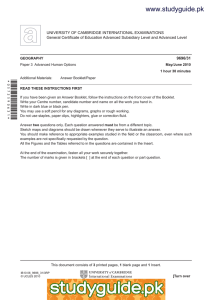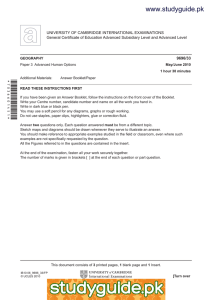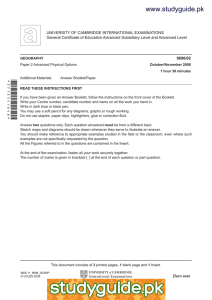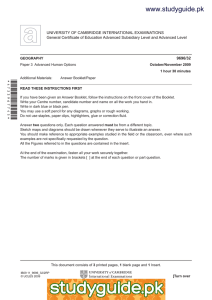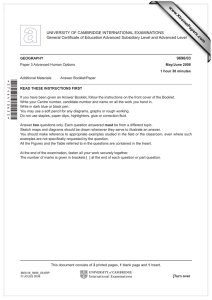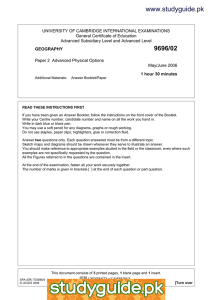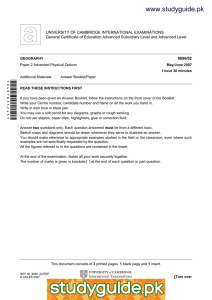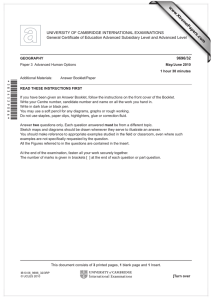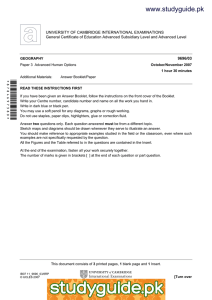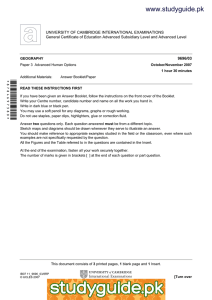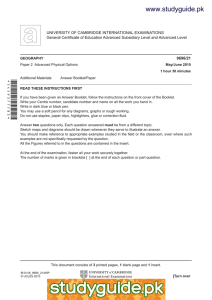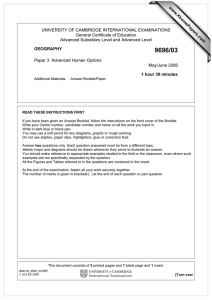www.studyguide.pk
advertisement
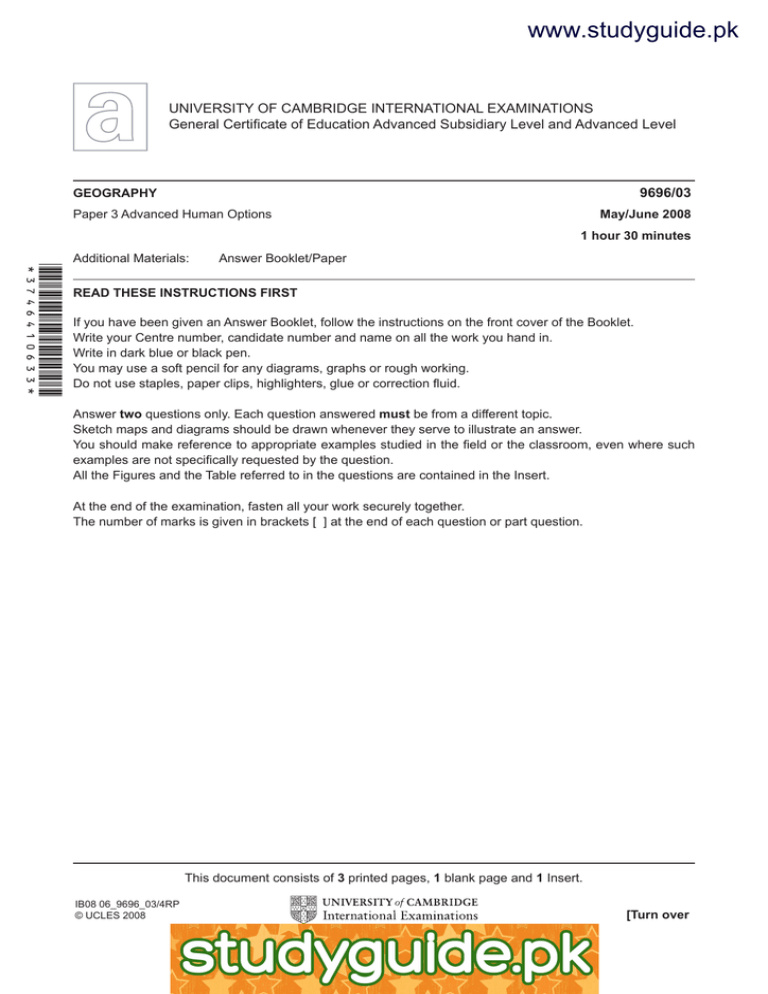
www.studyguide.pk UNIVERSITY OF CAMBRIDGE INTERNATIONAL EXAMINATIONS General Certificate of Education Advanced Subsidiary Level and Advanced Level 9696/03 GEOGRAPHY Paper 3 Advanced Human Options May/June 2008 1 hour 30 minutes *3746410633* Additional Materials: Answer Booklet/Paper READ THESE INSTRUCTIONS FIRST If you have been given an Answer Booklet, follow the instructions on the front cover of the Booklet. Write your Centre number, candidate number and name on all the work you hand in. Write in dark blue or black pen. You may use a soft pencil for any diagrams, graphs or rough working. Do not use staples, paper clips, highlighters, glue or correction fluid. Answer two questions only. Each question answered must be from a different topic. Sketch maps and diagrams should be drawn whenever they serve to illustrate an answer. You should make reference to appropriate examples studied in the field or the classroom, even where such examples are not specifically requested by the question. All the Figures and the Table referred to in the questions are contained in the Insert. At the end of the examination, fasten all your work securely together. The number of marks is given in brackets [ ] at the end of each question or part question. This document consists of 3 printed pages, 1 blank page and 1 Insert. IB08 06_9696_03/4RP © UCLES 2008 [Turn over www.xtremepapers.net 2 www.studyguide.pk Production, location and change Only one question may be answered from this topic. 1 (a) Table 1 shows the number of years that land was left fallow (uncultivated) on arable farms in three villages in south-east Nigeria in 2003. Nigeria is an LEDC in Africa. Fallowing promotes the recovery of soil fertility after a period of cultivation. (i) Compare the variation in the length of the fallow period in the villages surveyed. [4] (ii) Suggest reasons for the variation you described in (i). [6] (b) To what extent do you agree that the intensification of agriculture brings positive economic effects, but negative environmental effects? Support your answer with one or more examples. [15] 2 (a) (i) Give the meaning of the term industrial inertia. Explain why industrial inertia may occur. [5] (ii) Give the meaning of the term diseconomies of scale. Explain how diseconomies of scale may develop in manufacturing industry. [5] (b) Assess the relative importance of the factors affecting the location of one or more examples of manufacturing industry and / or related service industry. [15] Environmental management Only one question may be answered from this topic. 3 (a) Fig. 1 shows electricity generation by energy source for selected European countries in 2001. (i) Using Fig. 1, name the country which had the greatest dependence on two energy sources for its electrical power. [1] (ii) Give the percentage range of electrical power generated from renewable sources among the countries in Fig. 1. [1] (iii) Suggest reasons why the use of coal to generate electricity varies from country to country. [8] (b) To what extent does a rising standard of living account for changes in the demand for electricity in one country you have studied? [15] 4 Choose one example of a degraded environment. (a) Describe and explain the factors which contributed to the environment’s degradation. [10] (b) To what extent have attempts at upgrading the quality of your chosen environment been effective? [15] © UCLES 2008 9696/03/M/J/08 www.xtremepapers.net 3 www.studyguide.pk Global interdependence Only one question may be answered from this topic. 5 (a) With the help of examples, describe how changes in the global market may affect trade in visible goods. [10] (b) How may global inequalities in export earnings from tourism be explained? 6 [15] (a) Fig. 2 shows how local people’s attitudes to tourism may change as a destination develops. (i) Suggest reasons why local people welcome tourists initially in the stage called ‘Euphoria’ in Fig. 2. [5] (ii) Suggest possible ways of reducing conflicts between local people and tourists in the stage called ‘Antagonism’ in Fig. 2. [5] (b) To what extent has the development of one tourist area or resort you have studied brought positive changes to the lives of local people? [15] Economic transition Only one question may be answered from this topic. 7 (a) Describe and briefly explain the connections between industrial growth in some LEDCs and deindustrialisation in MEDCs. [10] (b) To what extent is the North-South divide, shown in Fig. 3, helpful in understanding today’s global economy? Support your answer with examples. [15] 8 Choose one country’s development policy at either the national scale or the regional scale (between the different regions within that country). (a) (i) (ii) Outline the government’s development priorities. Describe one government development project or scheme in your chosen country. [10] (b) Assess the extent to which the government’s development policy has been successful. [15] © UCLES 2008 9696/03/M/J/08 www.xtremepapers.net [Turn over www.studyguide.pk 4 BLANK PAGE Copyright Acknowledgements: Question 1 Question 3 Question 6 Table 1 © The Geographical Journal, Volume 171, Issue 3. November 2005. Fig. 1 © Nigel Hawkes; The Times, 21 November 2005. Fig. 2 © Stephen Williams; Tourism Geography; Routledge; 1998. Permission to reproduce items where third-party owned material protected by copyright is included has been sought and cleared where possible. Every reasonable effort has been made by the publisher (UCLES) to trace copyright holders, but if any items requiring clearance have unwittingly been included, the publisher will be pleased to make amends at the earliest possible opportunity. University of Cambridge International Examinations is part of the Cambridge Assessment Group. Cambridge Assessment is the brand name of University of Cambridge Local Examinations Syndicate (UCLES), which is itself a department of the University of Cambridge. 9696/03/M/J/08 www.xtremepapers.net
